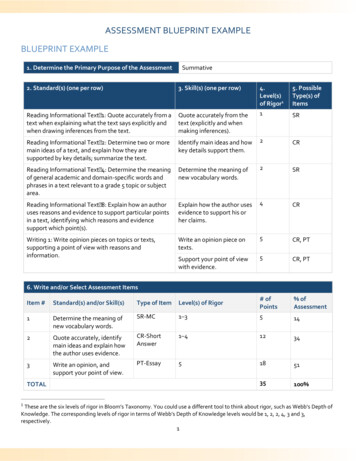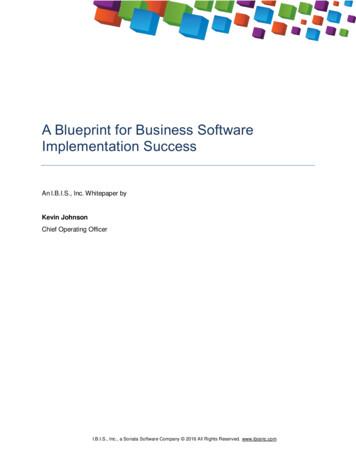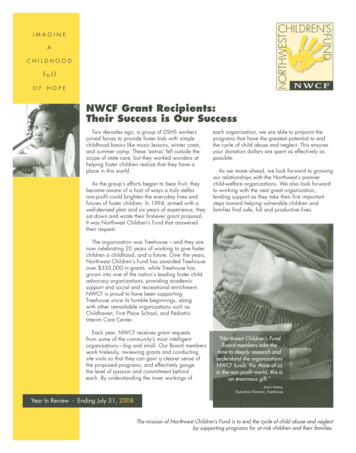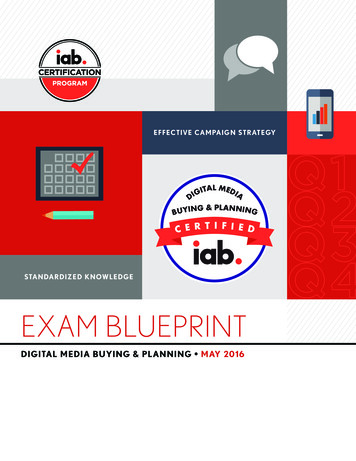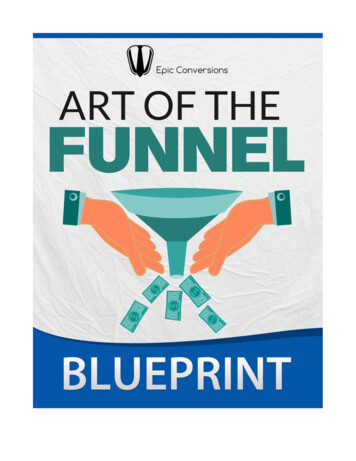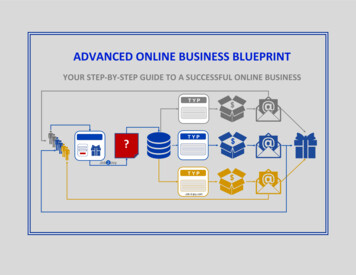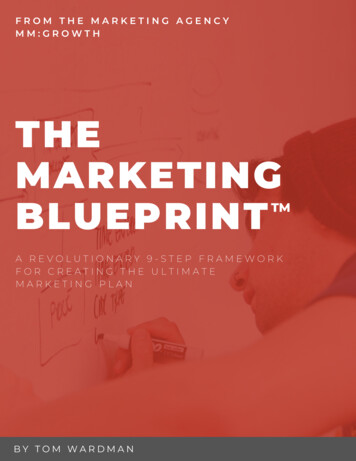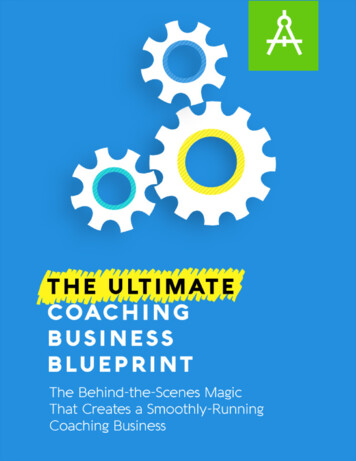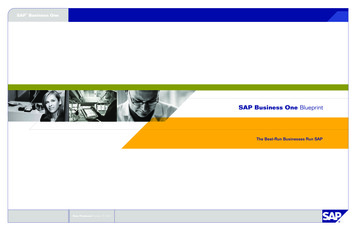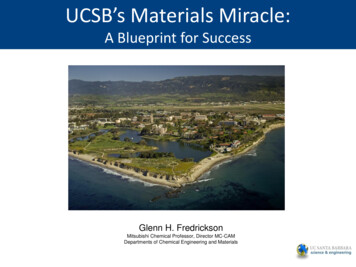
Transcription
UCSB’s Materials Miracle:A Blueprint for SuccessGlenn H. FredricksonMitsubishi Chemical Professor, Director MC-CAMDepartments of Chemical Engineering and Materials
2010 NRC Rankings: Materials Science & EngineeringOn September 28, 2010, The National Research Council (NRC) published its longawaited report evaluating over 5,000 doctoral programs in 62 fields at 212 universitiesThe 2010 rankings specified 5 percentile and 95 percentile confidence intervals using anumber of criteria. The most important of these are the so-called S (survey) and R(regression) rankingsOnly three other programs in the country share UCSB Materials "1111" ranking:Economics at Harvard, Statistics at Stanford, and Performing Arts at NYU
Young but DistinguishedUCSB College of Engineering: Founded 1961 – 50 yrs oldUCSB Materials Department Founded 1986 – 25 yrs oldHow did UCSB get to #1 inless than 25 years?
Engineering, top 10 by SIn fact, all five College of Engineering(COE) graduate programs in UCSB are "top10" (when the S ranking is used)We will see that UCSB’s broader successis intimately linked to the success inMaterials!
Outline Beginnings (1980-1990) Prerequisites Visionaries Multi-discipline Maturation (1990-2000) Shared facilities Centers Education and outreach Recognition (2000-2010) Closing Remarks
Beginnings (1980-1990)Robert MehrabianDean, COE 1983-1990
Prerequisites: build from strengthBy 1980, select areas of UCSB physical science and engineering hadestablished a national reputation for excellence: Physics Dept – led by an ambitious and talented faculty hired in the 1960s Institute for Theoretical Physics (est. 1979, now KITP) – used to attractNobel Laureate R. Schrieffer, F. Wilczek and others Institute for Polymers and Organic Solids (est. 1982, IPOS, now CPOS) –used to attract A. Heeger, F. Wudl in semiconducting polymers Electrical and Computer Engineering (ECE) – strategic focus on non-siliconsolid state science starting in 1976
The VisionaryAround 1980, informal discussions surrounding a materials programwere already taking place among R. Odette, G. Lucas, J. Merz, H.Kroemer, A. Heeger, J. Langer and othersThe effort was catalyzed by the arrival in 1983 of Robert Mehrabian asDean of the College of Engineering He was promised 15 FTE By the time Mehrabian left UCSB in 1990, he had made 69 hires!Robert Mehrabian 1968-75 – Asst./Assoc. Prof., Materials Science Dept., MIT1975-79 – Prof., Materials Science Dept., U. Illinois1979-83 – Director, Center for Mat. Sci., NBS1983-90 – Dean, COE, UCSB1990-97 – President, Carnegie Mellon University1999-11 – President, CEO, Chairman, Teledyne Technologies Inc.
Mehrabian’s Strategy1.Initially, build on the strength in ECE in III-V semiconductors and optoelectronics, and develop new initiatives in structural (metallic and ceramic)and macromolecular materials2.Forge alliances with key administrators and Academic Senate leaders3.Partner with industry, DOD, and DOE to satisfy startup equipment needs4.Recruit a leader for the new materials program5.Nucleate new areas with cluster hires of world-class mid-career faculty,many from industry. Reinforce with junior appointments6.New faculty are appointed jointly in new Materials Dept and an existingDepartment
Electronic Materials: Building on Strength in ECE Mehrabian, H. Kroemer, J. Merz, andothers forged a strategy around III-Vsemiconductors, heterojunctions, andoptoelectronics Key hires included Larry Coldren (1984, Bell Labs, optoelect.) Evelyn Hu (1984, Bell Labs,micro/nanofabrication) Pierre Petroff (1986, Bell Labs, quantumstructures) Art Gossard (1987, Bell Labs, MBE growth)Arthur Gossard NAS, NAECo-discoverer, quantum confined StarkeffectCo-discoverer fractional Hall effect3-time Winner of the AAAS NewcombCleveland Prize1078 papers, 43 citations/paperH-index: 106
Strategic AlliancesRobert A. HuttenbackChancellor 1977-1986Ray Sawyer (Physics)Executive Vice Chancellor 1982-1986Robert MehrabianDean, COE 1983-1990I was feeding at the same plate as everyone else, I was just hungrier!Robert Mehrabian, February 2011Academic Senate ChairR. Sawyer (Physics) 1980-81K. Millett (Math) 1982-83B. Kirtman (Chem) 1984-85D. Mellichamp (ChemE) 1990-92AS Committee on EducationalPolicy and Academic Planning(CEPAP)R. Odette (ME) 1985-1986G. Taborski (Bio) 1987R. Watts (Chem) 1988-1989
The Leader In the early 1980s, Mehrabian served on a DARPA advisorycommittee with Tony Evans of Berkeley/LBL After more than a year of courting, assisted by J. Langer, R.Schreiffer, A. Heeger and others, Tony decided to come to UCSBto head the new materials program Tony led the creation of a Materials Department and wrote manysuccessful proposals to the DOD (URI, DARPA, ONR), DOE andNSFAnthony G. Evans NAS, NAE, FRS ISI Highly cited author in Materials Science, Engineering & Physics Prior to UCSB, work experience at NBS, Rockwell, UC Berkeley Former Chair, Defense Sciences Research Council Founding Chair, Materials Dept, UCSB 1985-1994 799 papers, 47 citations/paper H-index: 97
Foundations of a Program By the time of the 1986Materials Dept proposal, thebasic structure was in place Evans and Mehrabian usedmid-career cluster hires to seedthe structural and polymersareas Many of these hires hadexperience at premiercorporate research labs: Bell LabsIBMExxon Corp. ResearchDuPont Experimental StationRockwell Research CenterA. G. Evans, A Proposal for a Department ofMaterials at UCSB, Feb 1986, pg. 64
“Bell Labs West”UCSB has probably the highest concentration of former Bell Labsemployees as current or former faculty:COE alone: Fred WudlJohn BowersArt GossardPierre PetroffJoe ZasadzinskiDale PearsonGlenn FredricksonLarry ColdrenKwang-Ting ChengEvelyn HuJim AllenMark RodwellJohn ShynkSanjit MitraTom SohHaitao ZhengLawrence Rabiner Bell Labs, 600 Mountain Ave., Murray Hill, NJ, 07974
Breaking Down Departmental BarriersNew faculty were given joint appointments between the Materials Dept. and existingDepts. in COE and MLPS: Inter-disciplinary research is the normGood for you is good for meIdeal platform for training studentsUCSBMaterials today
Strengthening Other DepartmentsExisting Departments in COE and MLPS derived a significant benefit fromthe infusion of world-class faculty jointly appointed with MaterialsCase in point: Chemical EngineeringMaterials Related Chemical (& Nuclear) EngineeringAppointments (1970-2000) Bob Odette (1970, structure materials/nuclear)Gene Lucas (1978, structural materials/nuclear)Phillip Pincus (1985, complex fluids theory, Exxon)Fred Lange (1986, ceramic processing, Rockwell)Joe Zasadzinski (1986, complex fluids microscopy, BellLabs)Jacob Israelachvili (1986, colloids & surfaces, ANU)Paul Smith (1987, polymer processing, DSM & DuPont)Dale Pearson (1987, polymer rheology, Exxon & Bell Labs)Gary Leal (1989, fluids and polymers, Caltech)Henry Weinberg (1989, surf. sci. & electronic matls., Caltech)Glenn Fredrickson (1990, polymer theory, Bell Labs)Brad Chmelka (1990, inorganic materials, UC Berkeley,Unocal)Eray Aydil (1993, electronic materials processing, U.Minnesota)Dmitri Maroudas (1994, computational materials, MIT)David Pine (1995, soft condensed matter, Exxon)Edward Kramer (1997, experimental polymer physics,Cornell)Matthew Tirrell (1999, biopolymer interfaces, U. Minnesota)1982 NRC Study – UCSB ChE not rated1995 NRC Study – UCSB ChE #142011 NRC Study – UCSB ChE #2
Maturation (1990-2000)Venky NarayanamurtiDean, COE 1992-1998
Shared FacilitiesStarting with Mehrabian and Evans, and fullydeveloped in the 1990s, UCSB pioneered thedevelopment of open-access user facilities formaterials characterizationToday, nearly all new pieces of major equipment areplaced in such facilitiesBenefits include: Broad range of instrumentationShared/leveraged costsProfessional staff to train users and maintain equipmentFacilitate collaborations across UCSB, with otheruniversities and industryCNSI Building 10,000 ft2Microscopy and MicroanalysisX-RaySpectroscopyEIIMBEMaterials ProcessingMOCVDMechanical TestingESB 10,000 ft2NanofabMRLPolymer CharacterizationX-RayChemistry
MRL Administered FacilitiesFacilityFaculty SupervisorDevelopment EngineerTEMPO:(formerly Chemistry)Ram SeshadriJoe DoyleComputation:(joint with CNSI)Frank BrownGlenn FredricksonPaul Weakliem, Jeffrey J. BarteetLinda HallMicroscopyand Microanalysis:James Speck(Committee Chair)Dr. Jan LofvanderDr. Tom MatesDr. Stefan KraemerMark CornishSpectroscopySong-I HanDr. Jerry HuNicole HolstromPolymer Characterization: Craig HawkerDr. K. BrzezinskaX-Ray Diffraction:Dr. Youli LiMorito DivinagraciaCyrus Safinya
MRL Facilities Use 2009User Departments ( 12):ECE, Chem. Engr., Materials, Mech. Engr., Biology, Chemistry,Geology, Marine Sci., Physics, CNSI, Environmental Sci., RechargedHours (2009)Facility# of Microscopy Ray348549076These facilities enable a spectacular range ofmaterials science across UCSB
External Users of MRL FacilitiesMRL Facilities – External Users – 2008Start-ups and Small CompaniesAdvantageous SystemsAerius an CoulterBioRad LabsCamet LabsC BriteCatalytic SolutionsCREEDupont DisplaysFLIR-Indigo SystemsFreedom PhotonicsGeneral MotorsGRT, IncHoneywellInlustraInnovative Micro Tech (IMT)Integrated Optoelectronics (Norway)International Radiation DetectorsKaaiLawrence Berkeley LabsL3-InfraredLaunchpoint Tech.Lockheed-Martin(SB Focal Plane)MC-RICNusilRaytheonSirigenSixPoint MaterialsSkyworks IncSmiths DetectionSoraaTeledyneThin SiliconToyota (USA)TransphormUSAVeecoZPowerUniversitiesAuburnCal State - CICalTechCornellFlorida InternationalHarvardKansas StateOakland University, Rochester, MIStanford UniversityUC IrvineUCLAUC RiversideUC San DiegoUC Santa CruzUniversity of MichiganUniversity of WisconsinUniversity of Southern California
Multidisciplinary Research CentersThe inter/multi-disciplinary structure of UCSB’s materials enterprise,coupled with outstanding leadership, spawned a broad range ofcenters in the decades following 1990Materials Research Laboratory (MRL)NSF-funded Materials Research Science & Engineering Center (MRSEC)Mitsubishi Chemical Center for Advanced Materials (MC-CAM)Solid State Lighting and Energy Center (SSLEC)California Nanosystems Institute (CNSI)International Center for Materials Research (ICMR)Center for Multifunctional Materials and StructuresCenter for Energy Efficient Materials (CEEM) and many more
Materials Research LaboratoryDirector – Craig J. HawkerAssociate Director – Ram SeshadriMRL Building Opening, March 1997A National Science Foundation Materials Research Science and Engineering Center (MRSEC)
MRL: A Hub of Materials ctureand G-4IRG-3FacilitiesEducation
History of the MRL Created in 1992 from a proposal led by Tony Evans.Tony Cheetham assumed the Directorship– 3 IRGs, 2.1M/yr from NSF Renewed in 1996– 4 IRGs, 3.0M/yr from NSF Moved into dedicated 14,000ft2 MRL building 1996 Renewed in 2000– 4 IRGs, 3.3M/yr from NSF Renewed in 2005, Craig Hawker becomes Director– 4 IRGs, 3.4M/yr from NSF Building expansion of 7,000ft2 completed byleveraging MC-CAM IC recovery
Functional materials via reversible interactionsGRAND CHALLENGE"To Understand the Structure – Property Relationshipbetween Synthetic, Biomimetic or Biological BuildingBlocks and Complex Functional Materials formed viaDynamic and Reversible Interactions”H
MRL Achievements from 10/2005-02/2009Science Output – High Impact, Visibility and InfluencePublications******426 publications102 Full 133 Partial Support191 Facilities Usageover 150 have 2 or more MRSEC PI’s58 articles in Science, Nature,Phys. Rev. Lett., and J. Am. Chem. Soc.2nd Most-Cited U.S. Institution (after MIT)in Materials Science, 1996-2006
Education Outreach Programs at the MRLDr. Dotty Pak, Education DirectorMRL Workshop SeriesMRL Summer SymposiumMRL Travel Fellowships (20-25 per year)Joint MRL/Materials Colloquium SeriesWIRED Magazine: RISE program as one of"10 stellar research internships" for 02/researchexperie.htmlFiona Goodchild received the 2002 Presidential Award forexcellence in Science, Mathematics & Engineering Mentoring*****174 undergraduate students103 Ph.D. students83 post-doctoral scholars23 RET teachers (160 other teachers)Over 100 visitors
Technology Outreach ProgramAnnual Materials Research Outreach Program (MROP)We have just held the 11th meeting in this seriesFellowships sponsored by Industry/FoundationsCSP Technologies, Air Products, Dow Chemical, othersComplex Fluids Design ConsortiumAn academic-industrial-national lab partnershipDOW-UCSB Competition for Young EntrepreneursBusiness planning and venture program
MRL Enables Other ProgramsMRL Building - 100% financed by indirect cost recovery- Incubator for new programs- Staff leveraged across multiple programsPartnershipsLeverage
The Mitsubishi Chemical – UCSB Alliance:A Model Research Partnership inAdvanced MaterialsGlenn Fredrickson, Director MC-CAMOOnm
MCHC Group OrganizationMitsubishi Chemical Holdings(MCHC)Net Sales 3.2 trillion100%56.3%100%100%Mitsubishi Chemical (MCC)Mitsubishi Tanabe Pharma (MTPC)Mitsubishi Plastics(MPI)Mitsubishi Rayon(MRC)4th Largest Chemical Company in the World
MCHC Business AreasElectronicsInformation Related ProductsRecordingMediumMedicineInorganic ChemicalsDiagnosticsProductsFood IngredientsBattery MaterialsFine ChemicalsPerformance ProductsHealth CareHealth CareElectronics ApplicationsDesigned MaterialsPlastic lsPharmaceuticalIngredientsand PlasticsCarbon ProductsSynthetic FiberRaw MaterialsClinicalTesting
A Unique Research Partnership Mitsubishi Chemical – Centerfor Advanced Materials (MCCAM), an international centerof excellence in functionalmaterials MCC taps into the broadinterdisciplinary materialsexpertise at UCSBUCSB researchers participate increating new materials forapplications in energy, displays,lighting, MC-CAM commenced in 2001 2nd generation 2006-20103rd generation 2010-2014
Why Did MCC Choose UCSB? A diverse set of faculty in materialsresearch ( 60 PIs) with a superb record ininterdisciplinary research and many withindustrial experienceAn administration and technology/industryalliances office that was supportive incrafting an agreement that was win-win forMCC and UCSB: Flexible IP termsIndirect cost of grant returned to buildspace for MC-CAMShared equipment and staff with MRLThese motivations are even more evident today!
MC-CAM Administrative StructureLarry Coldren, ActingDean of EngineeringMC-CAMGoverning Board6 membersMC-CAMMC-CAMSteering Committee10 membersMC-CAMResearch programsLeverage staff,space, equipmentwith MRLGlenn FredricksonDirectorTomohisa NakamuraAssociate DirectorCraig HawkerDirector of MaterialsResearch LabMRLMRLResearch Programs
Character of Research Projects Project co-leaders from UCSB andMCC MCC research partners are veryinvolved!2 employees of MitsubishiChemical America on campusResearchers from at least 2disciplinesScientific noveltyClear connection with a potentialproductInvolve the design of newfunctional materials, devices, orfabrication technologies
MC-CAM Project Statistics:2001-2005 Breakdown ofResearchers & Facultyin rials167Physics92 Project AreasAreaNo.Polymers & hybrids7Nanocomposites2Organic electronics &Phosphors13Fullerenes3Battery & fuel cells7
MC-CAM Research:World-class science and engineeringcathodeETLEML HTLOrganic white PLED fabricated by wet coatingHIL– Worlds best luminescent intensity ITOFuel Cell proton exchange membraneglass– Meeting DOE target III-V nano particle– Highest quantum efficiency Organic two photon absorption dye– Highest TPA cross section Functional polyolefins– First all polypropylene thermoplastic elastomer Phosphors– New important families of R,G,B,Y– White LED independent of Nichia patents Fullerene Derivatives– Enhanced solubility and functionality to add valueLED encapsulants– Thermal & uv stability, adhesion, andtransparencyOOnm
MC-CAM Publications & Presentations 98 publications to date inprestigious journals including Advanced MaterialsProc. NASAdvanced Functional Mater.J. Appl. Phys.NanolettersJ. Am. Chem. Soc.Chem. Mater.Synth. MetalsLangmuirMacromoleculesAngew. ChemiePhys. Rev. Lett. 86 presentations & posters todateIRP-1: Bazan, Shimizu
Patent Activity 67 patent disclosures to UCSB to date19 joint UCSB/(MCC or MC-RIC) applications21 US Patents issued/2 pending64 options elected12 licenses under discussion5 patents dropped by MCC, licensed to others ( 45Kreturned in patent costs)67 patents/98 papers is a very large ratio for auniversity research program!
Research Efficiency in InnovationResearch Institution Average1 3.2M expended per invention disclosure UCSB 2009: 1.8M Caltech 2009: 0.9M MIT 2009: 2.7MTech Company Rule of Thumb2 500K expended per invention disclosureMC-CAM2008: 231K expended per invention disclosure2009: 273KSince program inception: 260K/disclosureMC-CAM is more productive than all comparison groups!1. Average from 2009 AUTM licensing survey2. The Economist, October 22, 2005
Ongoing Challenges Maintaining clear channels ofcommunicationManaging expectations of UCSB facultyand MCC scientists and management Project timescalesInvolvement of MCC in researchBasic versus appliedKeeping UCSB faculty and researchersfocused on IP considerations andrelease proceduresBalancing UCSB’s research andeducational missions
Recognition (2000-2010)Matt TirrellDean, COE 1999-2009
UCSB Materials Department: Honors and Recognition Notable faculty distinctions 2 Nobel Laureates1 Millennium Prize Winner3 Members of the National Academy of Sciences8 Members of the National Academy of Engineering2 Fellows of the Royal Society2 Members American Academy of Arts and Sciences9 ISI Highly Cited ResearchersIndependent rankings NRC US Departmental Rankings (2010): #1Times Higher Education Worldwide (1999-2009): #3Essential Indicators: #2 citations/paper (1996-2006)Chronicle of Higher Education #1 (2006); #4 (2007)US News & World Report: #4 in US (2009)
Alan HeegerNobel LaureateChemistry 2000Herb KroemerNobel LaureatePhysics 2000Shuji NakamuraMillenniumTechnology Prize2006UC Santa Barbara: World-Renowned Science in a Beautiful Setting46
High Impact Publications – MRLTriblock Copolymer Syntheses of Mesoporous Silicawith Periodic 50 to 300 Å PoresZhao DY, Feng JL, Huo QS, Melosh N, Fredrickson GH,Chmelka BF, Stucky GD Science 279, 548-552 (1998)Cited 4027 timesOpen-framework inorganic materialsCheetham AK, Férey G, Loiseau TAngew. Chem., Intl Ed. 38, 3268/9-3292 (1999)Cited 1577 timesPolymer photovoltaic cells-enhanced efficiencies via anetwork of internal donor-acceptor heterojunctionsYu G, Gao J, Hummelen JC, Wudl F, Heeger AJScience 270, 1789-1791 (1995)Cited 2718 times
Former MRL ResearchersOur greatest product is peopleProf. Barbara Albert, 1995-1996 (Univ. Hamburg)Prof. Angie Belcher, 1992-1999 (MIT)Prof. Branton Campbell, 1995-1999 (Brigham Young)Prof. Effie Kokkoli, 1999-2001 (Minnesota)Prof. Tonya Kuhl, 1992-2000 (UC Davis)Dr. Gerhard Theurich, NASA Center for Comp. SciencesProf. Michael McGehee, 1994-1999 (Stanford)Prof. Russell Morris, 1992-1995 (St. Andrew’s Univ.)Prof. Ferdi Schüth, 1995-1998, Director, MPI fürKohlenforschungProf. Andrea Liu, 1993-1996 (U. Penn)Prof. Peidong Yang, 1997-1999 (UC Berkeley)Prof. Venkat Ganesan, 1999-2001 (U. Texas)Angela BelcherMRL graduate st
awaited report evaluating over 5,000 doctoral programs in 62 fields at 212 universities The 2010 rankings specified 5 percentile and 95 percentile confidence intervals using a . (COE) graduate programs in UCSB are "top 10" (when the S ranking is used) We will see that UCSB
